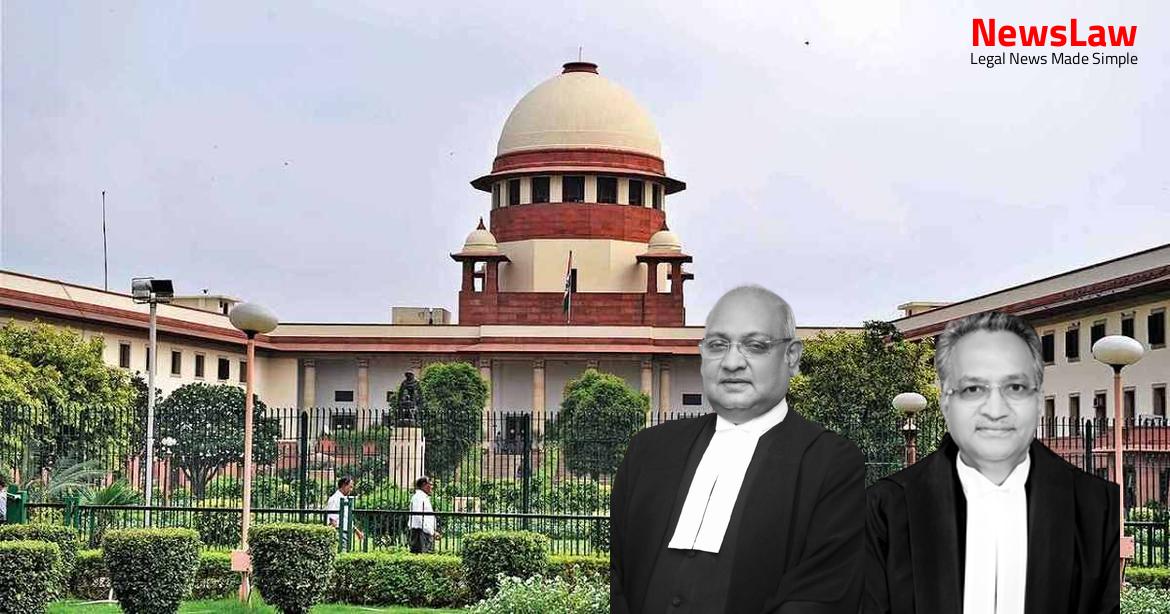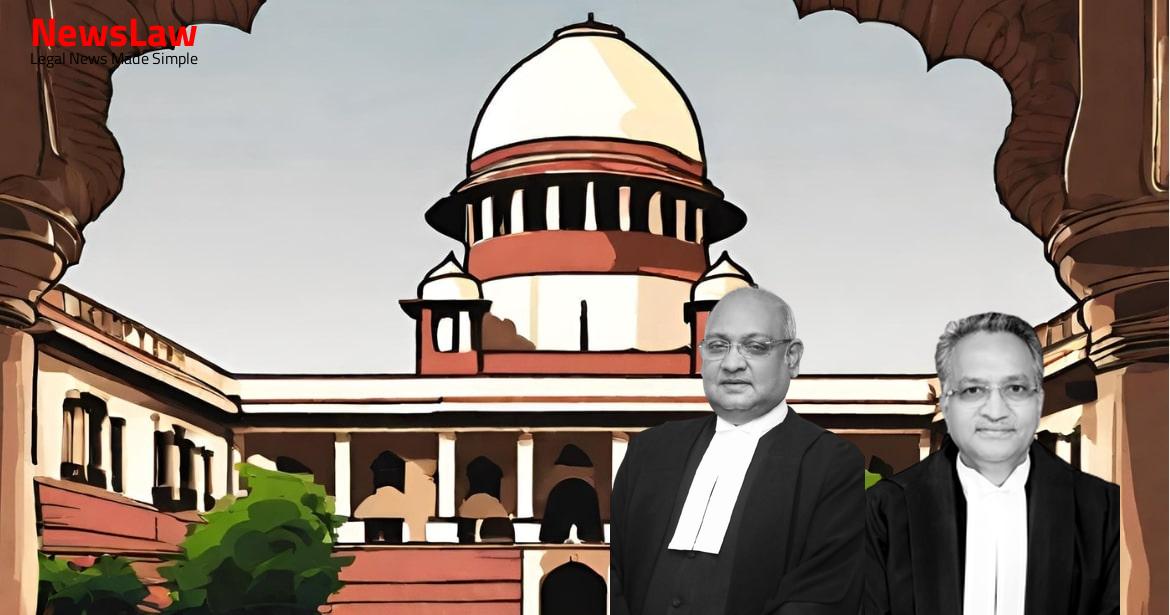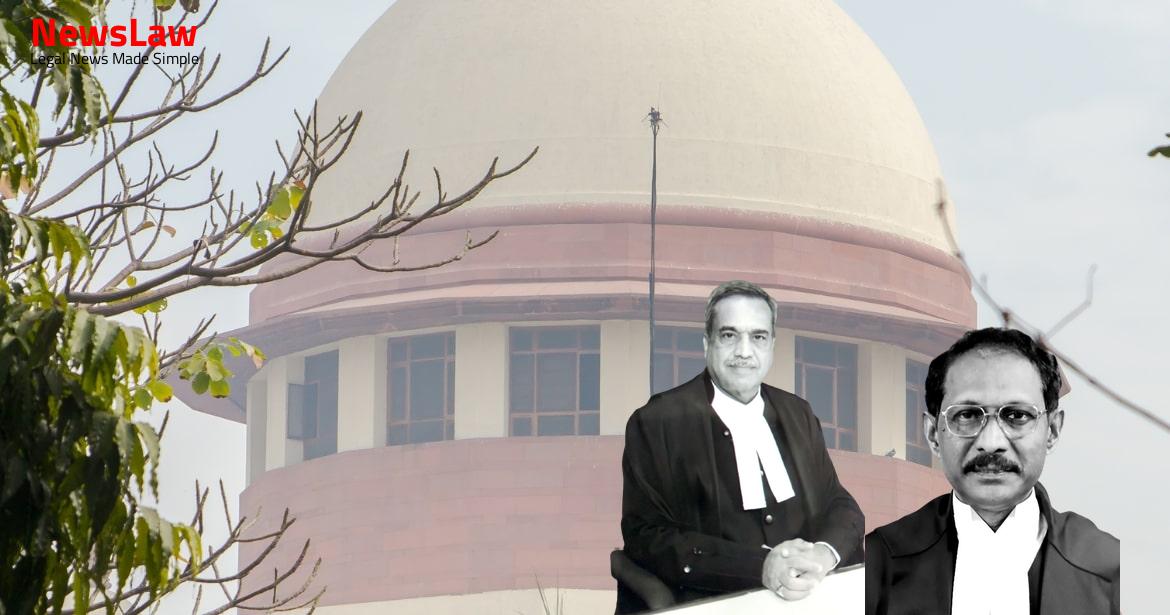In a significant legal battle, the Supreme Court of India deliberated on the case of alleged self-defense where Jayapal was pitted against The State of India. The judgment examines the complexities surrounding the incident and the application of legal principles in determining the outcome. Dive into the details of this intriguing case to understand the implications of the court’s decision. #LegalCase #SupremeCourt #IndianLaw
Facts
- Accused No. 2 was acquitted of the charge under Section 302/34 IPC by the High Court, while Accused No. 1’s conviction under Section 302 IPC was affirmed.
- The Trial Court found that Accused No. 2 had an aruval but no corresponding injury was found on the deceased.
- Accused No. 3, the wife of Accused No. 1, was acquitted by the Trial Court due to lack of evidence linking her to the crime.
- High Court upheld the Trial Court’s decision regarding the conviction of Accused No. 1 under Section 302 IPC, citing substantial evidence against him.
- Witness testimonies raised doubts about Accused No. 2’s involvement as no corresponding injury was found on the deceased.
- Prosecution failed to establish the guilt of Accused No. 3, who had two young children and no evidence of her carrying a weapon during the crime.
- The deceased Poondaichelian had a conflict with accused No 3 Jayaseeli over town panchayat elections.
- Accused No 3 made a false complaint against the deceased, causing further animosity.
- On the day of the incident, accused No 1 Jayapal threatened to finish off the deceased within 24 hours.
- The accused, including Jayapal, Jayaseeli, and Savier, ambushed the deceased while he was crossing the lane.
- Accused No 2 attempted to attack the deceased with a sickle, but the blow was blocked.
- Finally, Jayapal stabbed the deceased in the chest with a spike, resulting in the victim’s death.
- Eyewitnesses confirmed the sequence of events leading to the fatal injury inflicted by the accused.
- The prosecution’s case was supported by the testimonies of witnesses and the circumstances of the incident.
- The Trial Court rejected the defense version, concluding that the appellant, Jayapal, caused the fatal injury to the deceased.
Also Read: Constitutional Validity of Domicile-based Reservation in PG Medical Courses
Issue
- The basic question in this appeal is whether the High Court was justified in maintaining the appellant’s conviction under Section 302 IPC.
- The relevant background includes the facts and circumstances leading to this question.
- The key issue to be determined is the validity of the appellant’s conviction in the given context.
Also Read: Unlawful Assembly: Collective Liability Judgment by Supreme Court of India
Arguments
- The appellant’s counsel argues that the appellant was acting in good faith to protect his wife from assault and molestation by the deceased, who had illegally entered their house.
- The counsel refers to various legal precedents to support the argument that this was a case of exercising the right of private defence.
- It is contended that the appellant’s actions were not intended to cause death but were in response to the sudden provocation of the deceased entering their house and attempting harm.
- Counsel cites cases such as Munshi Ram v. Delhi Administration and James Martin v. State of Kerala to strengthen the argument.
- On the other hand, the respondent’s counsel asserts that the appellant had prior intentions of causing death due to enmity.
- Witnesses have indicated that the incident took place on the road outside the appellant’s house, leading to the contention that it was not a case of self-defence or sudden provocation.
- The nature of the fatal injury on the deceased suggests the act falls under the main provision of Section 300 IPC, according to the respondent’s counsel.
- The appellant is not entitled to the benefit of any of the Exceptions of Section 300 IPC.
- The appellant deserves to be convicted for the offence under Part-I of Section 304 IPC, for the offence of culpable homicide not amounting to murder.
- Referral and reliance on decisions in Pulicherla Nagaraju alias Nagaraja Reddy v. State of A.P.: (2006) 11 SCC 444 and Gudar Dusadh v. State of Bihar: (1972) 3 SCC 118.
- Analysis of Section 299 IPC specifying the offence of culpable homicide.
- Analysis of Section 300 IPC specifying the offence of murder.
- Clarification of the criteria for culpable homicide and murder.
Also Read: The Mystery of Strangulation: A Landmark Judgment by the Supreme Court of India
Analysis
- The prosecution’s case of the incident occurring at the doorstep of the appellant’s house is in doubt but likely took place there.
- The defense version of the deceased barging into the appellant’s house and assaulting his wife lacks evidence.
- The Trial Court and High Court acquitted accused No 2 and accused No 3, indicating disbelief in the prosecution’s case against them.
- The appellant’s claim of acting in self-defense inside his house is considered due to the lung-piercing injury on the deceased.
- Investigating Officer recovered the weapon of offense from the house of the appellant, indicating a possible altercation on the doorstep.
- The prosecution failed to prove all doubts concerning the place and manner of occurrence, casting further doubts on the case.
- The disputes and discrepancies within the prosecution’s case render its credibility questionable, leading to disbelief in certain aspects.
- The acquittal of accused No 2 and accused No 3 significantly alters the prosecution story’s dynamics, emphasizing their involvement.
- The situation does not support a claim of private defense or premeditated attack, indicating a sudden quarrel under Section 300 of the IPC.
- Despite disbelief in parts of the prosecution’s case, the appellant’s involvement in the incident and causing harm to the deceased are evident.
- The defense’s exaggeration and lack of convincing evidence weaken claims of self-defense, shifting focus to the varied testimonies and inconsistencies.
- The sequence of actions by the accused persons may differ in testimonies, but reliability and trustworthiness of witnesses play a crucial role.
- While doubts persist and the prosecution’s version is cast in doubt, the appellant’s right of self-defense remains a valid consideration in the case.
- Section 302 IPC provides punishment for murder, while Section 304 provides punishment for culpable homicide not amounting to murder.
- Exception 1 of Section 300 IPC states that culpable homicide is not murder if the offender, deprived of self-control by provocation, causes death.
- Exception 1 has provisos ensuring the provocation is not sought, provoked voluntarily, or done in obedience to the law.
- Explanation states that culpable homicide is not murder if it is committed without premeditation in a sudden fight.
- Section 304 IPC states the punishment for culpable homicide not amounting to murder with varying degrees based on intention and knowledge.
- Exception 2 of Section 300 IPC provides instances where culpable homicide is not classified as murder.
- Previous enmity between the parties was noted by the Court.
- Father and brother of the deceased had been previously attacked by the appellant and his father.
- No indication of any cause for an apprehension that the deceased might attack the appellant.
- The act of the appellant causing an injury on a vital part of the body by stabbing with great force was considered as murder.
- Principles of self-defence mentioned in Munshi Ram and other cases were acknowledged by the Court.
- The appellant needed to show a reasonable apprehension to invoke the right of self-defence.
- Cases of Budhi Singh and Surain Singh were referred to for similar situations.
- Each case should be examined on its own facts to determine the nature of the offence.
- Likelihood of the deceased, who was on inimical terms with the wife of the appellant, being provoked by aggression or intrusion was not ruled out.
- The Court referred to the case of Jumman and Ors. v. The State of Punjab regarding ambiguity in deciding roles of parties.
- The Court emphasized the principle of separating truth from falsehood in evidence evaluation.
- The maxim ‘falsus in uno, falsus in omnibus’ was discussed in the Indian context, stating it is a rule of caution and not a mandatory rule of evidence.
- Court’s discretion to differentiate between acquitted and convicted accused was highlighted.
- Rejecting a whole body of testimony based on some untruths was cautioned against to prevent obstruction of criminal justice.
- Exception 4 of Section 300 IPC is extended to the appellant.
- Appellant’s act leading to death was intentional with the intention of causing bodily injury likely to cause death.
- Appellant convicted for offence under Part-I of Section 304 IPC.
- Judges inclined to accept appellant’s alternative case that incident occurred without premeditation, in heat of passion during sudden fight upon a sudden quarrel.
- Appellant did not take undue advantage or act in a cruel or unusual manner.
Decision
- The appellant’s conviction under Section 302 IPC has been altered to Part-I of Section 304 IPC.
- The appellant has been sentenced to undergo imprisonment for ten years.
- The sentence regarding fine and default stipulation remains unchanged.
Case Title: R.JAYAPAL Vs. THE STATE OF TAMIL NADU
Case Number: Crl.A. No.-000056-000056 / 2010



